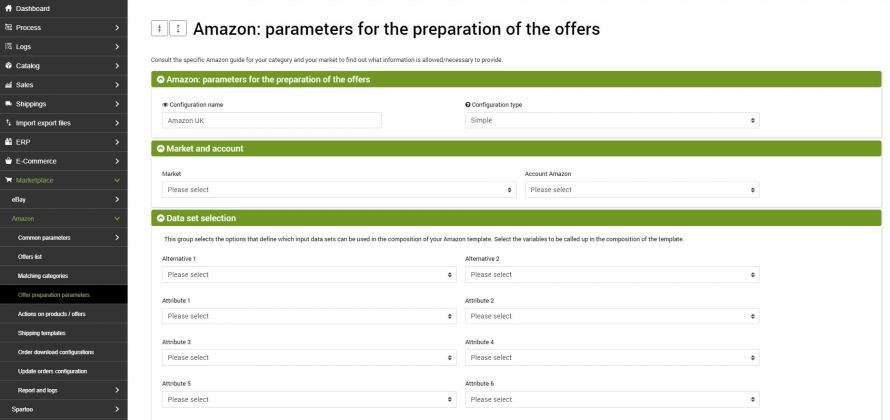Here we will see how to configure the parameters for the preparation of offers when these are already present on the marketplace.
All items that have been published and described by other sellers in the past, and that have a unique code within the marketplace, are considered as products already present on Amazon.
EXAMPLE: Nokia Lumia 630 Smartphone, 8GB, Black - ASIN CODE B00JR983HC
To create the appropriate configuration go to the menu:
Marketplace --> Amazon --> Offer preparation parameters
By clicking on Add, the section dedicated to the parameters for preparing offers will open.
Once the name has been assigned, for example, "Amazon UK", it is time to choose the type of configuration. In the case of products already present on Amazon it is advisable to choose the Simple configuration.
By clicking on SAVE AND CONTINUE the page will be updated with all the additional fields to be filled in.
Market and Account
- Market: select the reference market from among the options provided for the publication of offers.
- Account: select the type of account from the options provided.
Data set selection
The options are selected that define which data sets can be used in the composition of your Amazon template (alternatives, attributes, price lists). Select the variables that you want to recall in the generation of offers.
Example: Attribute 1 - Color, Attribute 2 - Size
Placeholder markers
The elements inserted between the {[(...)]} markers will be replaced with the specific value when generating the alternative description. Values not indicated in markers will be inserted as fixed values.
The placeholders that can be used in the template are the following:
Basic product information
Product code: {[(product|sku)]} - Manufacturer reference: {[(product|manufacturer_reference)]} - Product name: {[(product|name)]} - Short description: {[(product|s_desc)]} - Full description: {[(product|desc)]} - Available quantity: {[(product|in_stock)]} - Ordered quantity: {[(product|in_stock_order)]} - Weight: {[(product|weight)]} - Weight unit of measure: {[(product|weight_uom)]} - Length: {[(product|length)]} - Width: {[(product|width)]} - Height: {[(product|height)]} - Linear unit of measure: {[(product|lwh_uom)]}- Notes: {[(product|notes)]} - Free 1 {[(product|free1)]} .... Free 7 {[(product|free7)]} - Metatitle {[(product|meta_title)]} - Metadescription {[(product|meta_description)]} - Metakeywords {[(product|meta_keywords)]}
Manufacturer name: {[(manufacturer|mf_name)]} - Manufacturer email: {[(manufacturer|mf_email)]} - Manufacturer URL: {[(manufacturer|mf_url)]} - Manufacturer description: {[(manufacturer|mf_desc)]} - Manufacturer image: {[(manufacturer|image)]} - Resized manufacturer image: {[(manufacturer|w==pixel|h==pixel|image)]} - Free 1 {[(manufacturer|free1)]} .... Free 7 {[(manufacturer|free7)]}
Information from alternatives (change the number for the various alternatives from 1 to 2), for example for alternative 1:
Product name: {[(alternative1|product_name)]} - Subtitle: {[(alternative1|product_subtitle)]} - Short description: {[(alternative1|product_s_desc)]} - Decsription: {[(alternative1|product_desc)]} - Notes: {[(alternative1|notes)]} - Manufacturer name: {[(alternative1|mf_name)]} - Manufacturer email: {[(alternative1|mf_email)]} - Manufacturer description: {[(alternative1|mf_desc)]} - Manufacturer Url: {[(alternative1|mf_URL)]}
Information from the attributes (change the number for the various attributes from 1 to 8), for example for attribute 1:
Attribute label: {[(attribute1|name)]} - Attribute value list: {[(attribute1|value)]} - Converted value: {[(attribute1|kind==Shoes|rescale_from==us_man|rescale_to==eu_man|value)]}
Prices (change the number for the various price lists from 1 to 2), for example for price list 1:
Pricelist name: {[(list1|name_list)]} - Price excluding VAT: {[(list1|net_price)]} - Price including VAT: {[(list1|gross_price)]} - VAT rate: {[(list1|vat)]} - Discounted price: {[(list1|override_price)]}
Product identification
- Product code: if the barcode is in the normal field used for barcodes in the product table, it is advisable to leave the value {[(product | barcode)]}. Otherwise, fill in with the most suitable Tag.
- Exclude products without valid product code: it is possible to exclude from the generation of offers those products that do not have a valid unique code.
- Product code type: fill in according to the nature of the barcodes that identify the products (EAN, UPC, ASIN, ISBN ...)
Basic product information (MANDATORY DATA)
- Manufacturer/Publisher: name of the manufacturing company
- Brand/Author: name, term, model or symbol that differentiates the product from that of other sellers. The value can coincide with that of the Manufacturer/Publisher
- Title/Parent name/parent product: short title that will be shown in bold on the product page and in the title bar in the browser window. It is advisable to check the parameters required by Amazon for the compilation of this field in the various markets.
- Title/variant name/child product: short title including color and size. Example: Men's polo shirt, White, XL --->{[(product|name)]}{[(attribute1|name)]}{[(attribute1|value)]}
Offer information
- Product condition: indicate a valid value that identifies the condition of the product.
- Processing time: indicate a numerical value that identifies the number of days expected for order fulfillment.
- Notes on product condition: It is possible to enter a description on the condition of the asset or to dynamically recall it from an attribute if available
Shipping
- Shipping by: indicate whether shipments are by the manufacturer or by Amazon.
The other fields are to be filled in based on the characteristics of the packaged product.
Finally click on SAVE AND CLOSE to terminate the process.
Thank you for rating this article.





